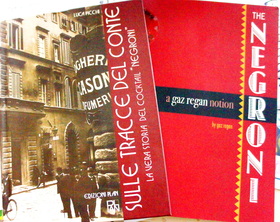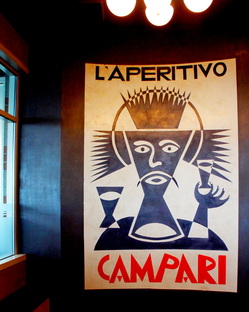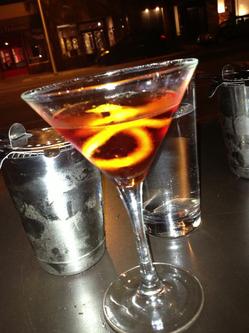So much Campari! So many Negronis! In the US, it's sold at 48 proof, the Campari; at the Duty-Free it's 57 proof, and about half the price. Worth bringing back.
 In Seattle, Negronis are almost invariably shaken and served up, with an orange twist that's draped or drooped, depending on the barman's finesse. You don't need to be a mixologist to assemble the Negroni: it's one third gin, one third sweet vermouth, one third Campari. In Italy, it's almost always served over ice in a rocks glass with a slice of orange. At the late, lamented Txori in Belltown, barman Brett Paulson would garnish with a quarter slice, a "flag."
In Seattle, Negronis are almost invariably shaken and served up, with an orange twist that's draped or drooped, depending on the barman's finesse. You don't need to be a mixologist to assemble the Negroni: it's one third gin, one third sweet vermouth, one third Campari. In Italy, it's almost always served over ice in a rocks glass with a slice of orange. At the late, lamented Txori in Belltown, barman Brett Paulson would garnish with a quarter slice, a "flag."
Wine & spirits guy Gary "Gaz" Regan put out a slim book last year about the Negroni. A few anecdotes, a lot of "recipes." I'm not really a fan Negroni recipes (or variations, or deiviations, or "our version"). But I'll make allowances.
 The other book in the picture is Italian, Sulle Tracce del Conte, "On the Trail of the Count," by Luca Picchi. He traces the life and drinking habits of a nobleman named Count Camillo Negroni, who, one day in the 1920s asked the waiter at his favorite bar in Florence, the Caffè Casoni, to serve him something stronger than his regular Americano (Campari, vermouth, soda water). The barman substituted gin for the soda water, and the Negroni was born. If you don't read Italian, this blog post by Camper English will fill you in.
The other book in the picture is Italian, Sulle Tracce del Conte, "On the Trail of the Count," by Luca Picchi. He traces the life and drinking habits of a nobleman named Count Camillo Negroni, who, one day in the 1920s asked the waiter at his favorite bar in Florence, the Caffè Casoni, to serve him something stronger than his regular Americano (Campari, vermouth, soda water). The barman substituted gin for the soda water, and the Negroni was born. If you don't read Italian, this blog post by Camper English will fill you in.
If you don't have gin, you can use sparkling wine (Prosecco, Champagne, etc.), but then it's called "Sbagliato"--a mistake. You can use vodka instead, and call it a Negroski. You can use dry vermouth instead of sweet; then it's a Cardinale. There's a whole category of "white" Negronis, made without Campari. (Why bother? Just drink gin.) One recipe adds a measure of water and calls for 12 seconds in the microwave.(Ugh.)
 The indispensable ingredient of the true Negroni is, of course, Campari itself, first concocted in Milano in the 19th century by Gaspare Campari, a pharmacist in Milan. In those days, pharmacists were the folks who knew something about distilling and had access to exotic herbs. Today, any high school kid with a chemistry set could do it, but the Europeans were the ones, back in the day, who invented the macerations and tinctures, the amari and digestivi, that we still enjoy today. I'll leave it to historians to explain why today's Campari tastes more syrupy and less distinctively bitter than when I first encountered it; I just try to enjoy one (maybe two) every day. Usually as an aperitif, but occasionally as an after-dinner drink. Yesterday, on a warm spring night, at a sidewalk café in Belltown, surrounded by high-rise condos, with music leaking out of the windows, just watching the passing parade (couples, families, strollers, dogs), with this quintessentially urban drink in your hand, I could even imagine that Seattle was a real city.
The indispensable ingredient of the true Negroni is, of course, Campari itself, first concocted in Milano in the 19th century by Gaspare Campari, a pharmacist in Milan. In those days, pharmacists were the folks who knew something about distilling and had access to exotic herbs. Today, any high school kid with a chemistry set could do it, but the Europeans were the ones, back in the day, who invented the macerations and tinctures, the amari and digestivi, that we still enjoy today. I'll leave it to historians to explain why today's Campari tastes more syrupy and less distinctively bitter than when I first encountered it; I just try to enjoy one (maybe two) every day. Usually as an aperitif, but occasionally as an after-dinner drink. Yesterday, on a warm spring night, at a sidewalk café in Belltown, surrounded by high-rise condos, with music leaking out of the windows, just watching the passing parade (couples, families, strollers, dogs), with this quintessentially urban drink in your hand, I could even imagine that Seattle was a real city.

Leave a comment